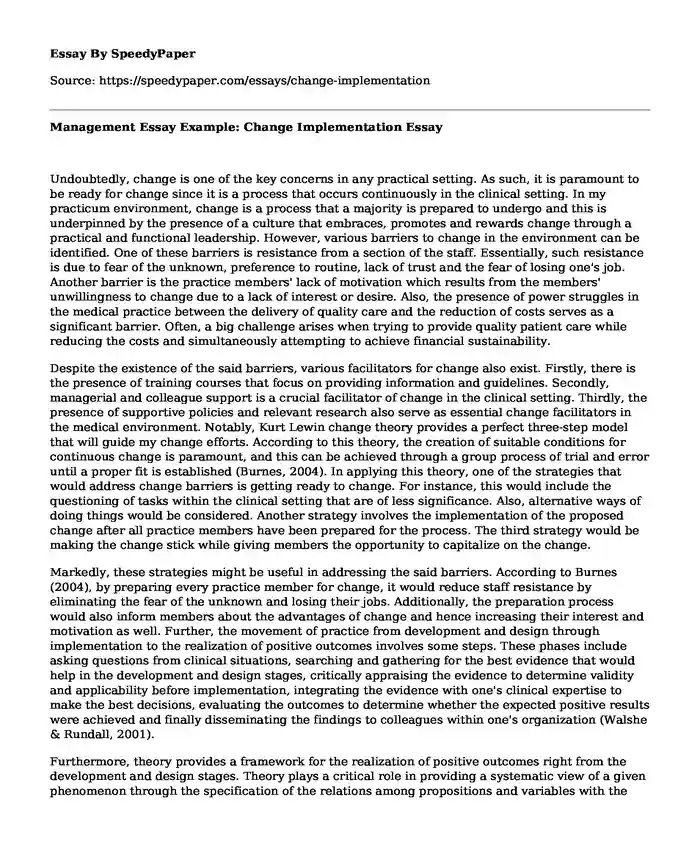
| Type of paper: | Course work |
| Categories: | Management |
| Pages: | 3 |
| Wordcount: | 709 words |
Undoubtedly, change is one of the key concerns in any practical setting. As such, it is paramount to be ready for change since it is a process that occurs continuously in the clinical setting. In my practicum environment, change is a process that a majority is prepared to undergo and this is underpinned by the presence of a culture that embraces, promotes and rewards change through a practical and functional leadership. However, various barriers to change in the environment can be identified. One of these barriers is resistance from a section of the staff. Essentially, such resistance is due to fear of the unknown, preference to routine, lack of trust and the fear of losing one's job. Another barrier is the practice members' lack of motivation which results from the members' unwillingness to change due to a lack of interest or desire. Also, the presence of power struggles in the medical practice between the delivery of quality care and the reduction of costs serves as a significant barrier. Often, a big challenge arises when trying to provide quality patient care while reducing the costs and simultaneously attempting to achieve financial sustainability.
Despite the existence of the said barriers, various facilitators for change also exist. Firstly, there is the presence of training courses that focus on providing information and guidelines. Secondly, managerial and colleague support is a crucial facilitator of change in the clinical setting. Thirdly, the presence of supportive policies and relevant research also serve as essential change facilitators in the medical environment. Notably, Kurt Lewin change theory provides a perfect three-step model that will guide my change efforts. According to this theory, the creation of suitable conditions for continuous change is paramount, and this can be achieved through a group process of trial and error until a proper fit is established (Burnes, 2004). In applying this theory, one of the strategies that would address change barriers is getting ready to change. For instance, this would include the questioning of tasks within the clinical setting that are of less significance. Also, alternative ways of doing things would be considered. Another strategy involves the implementation of the proposed change after all practice members have been prepared for the process. The third strategy would be making the change stick while giving members the opportunity to capitalize on the change.
Markedly, these strategies might be useful in addressing the said barriers. According to Burnes (2004), by preparing every practice member for change, it would reduce staff resistance by eliminating the fear of the unknown and losing their jobs. Additionally, the preparation process would also inform members about the advantages of change and hence increasing their interest and motivation as well. Further, the movement of practice from development and design through implementation to the realization of positive outcomes involves some steps. These phases include asking questions from clinical situations, searching and gathering for the best evidence that would help in the development and design stages, critically appraising the evidence to determine validity and applicability before implementation, integrating the evidence with one's clinical expertise to make the best decisions, evaluating the outcomes to determine whether the expected positive results were achieved and finally disseminating the findings to colleagues within one's organization (Walshe & Rundall, 2001).
Furthermore, theory provides a framework for the realization of positive outcomes right from the development and design stages. Theory plays a critical role in providing a systematic view of a given phenomenon through the specification of the relations among propositions and variables with the aim of explaining or predicting phenomena in the practical setting (Walshe & Rundall, 2001). Precisely, in healthcare, theory provides a framework for understanding the relationship between resources and inputs at the development and design stages, program activities involved in the implementation phase and anticipated positive outcomes or outputs. Principally, some of the barriers that I might encounter in the movement of a practice issue to the realization of positive outcomes include my colleagues' criticism and resistance, distrust in evidence and difficulties in introducing change to the current model of practice.
References
Burnes, B. (2004). Kurt Lewin and the planned approach to change: a reappraisal. Journal of Management studies, 41(6), 977-1002.
Walshe, K., & Rundall, T. G. (2001). Evidencebased management: from theory to practice in health care. The Milbank Quarterly, 79(3), 429-457.
Cite this page
Management Essay Example: Change Implementation. (2022, Nov 07). Retrieved from https://speedypaper.com/essays/change-implementation
Request Removal
If you are the original author of this essay and no longer wish to have it published on the SpeedyPaper website, please click below to request its removal:
- Free Essay Containing Art History Reading Comprehension
- Free Essay on Internet Privacy Resolution
- Free Essay about Intergovernmental Relationships and Policing
- Free Essay Example on Behavior Modification
- Essay Example on How Video Games Changed My Life
- Free Essay: The Glass Menagerie by Tennessee Williams
- Business Ethics Essay Sample: Nissan Cars Case, Insider Trading and Other Ethical Dilemmas
Popular categories




